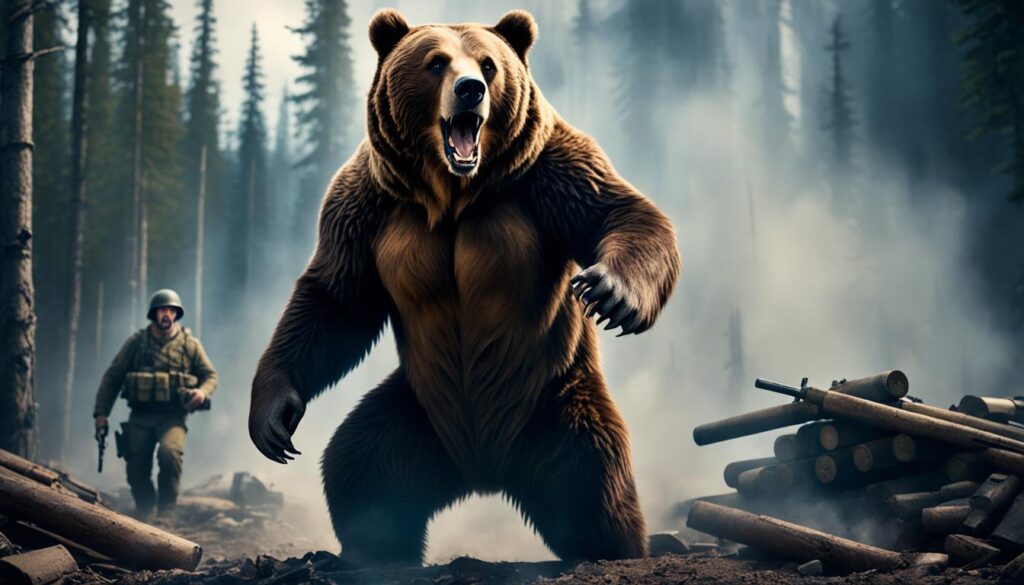In a remarkable tale of unconventional camaraderie during World War II, a Syrian brown bear named Wojtek became an integral part of the Polish Army, even earning the rank of corporal. This extraordinary story began when Polish soldiers, evacuated from the Soviet Union, adopted the orphaned bear cub in Iran. Wojtek quickly became more than just a mascot; he was a cherished companion and a valuable asset to the 22nd Artillery Supply Company.
As a private in the Polish Army, Wojtek was officially enlisted to ensure he received proper rations and transportation. His unique role extended beyond boosting morale; during the pivotal Battle of Monte Cassino in 1944, the bear corporal actively participated in moving ammunition crates, showcasing his strength and dedication to his fellow soldiers.
After the war, Wojtek’s journey took him to Scotland, where he found a new home at the Edinburgh Zoo. Until his passing in 1963, he remained a symbol of the unbreakable bond forged between a bear and his human comrades during one of history’s darkest chapters.
Key Takeaways
- Wojtek, a Syrian brown bear, served as a corporal in the Polish Army during WWII
- Polish soldiers adopted Wojtek as a young orphaned cub in Iran
- The bear was officially enlisted to provide for his rations and transportation
- Wojtek helped move ammunition during the Battle of Monte Cassino in 1944
- After the war, Wojtek lived at the Edinburgh Zoo in Scotland until his death in 1963
Wojtek: The Orphaned Bear Cub Adopted by Polish Soldiers
In the spring of 1942, the Polish Anders’ Army, accompanied by civilian refugees, left the Soviet Union for Iran. During this journey, Polish soldiers encountered a young Iranian boy who had found an orphaned bear cub. Irena Bokiewicz, an 18-year-old refugee, convinced Lieutenant Anatol Tarnowiecki to buy the cub, which spent three months in a Polish refugee camp near Tehran under Irena’s care. This event marked the beginning of Wojtek’s early life as an unusual army mascot.
In August, the bear cub was donated to the 22nd Artillery Supply Company and named Wojtek. The soldiers took on the responsibility of bear cub care, initially feeding him with condensed milk from a vodka bottle. As Wojtek grew, his diet expanded to include fruit, marmalade, honey, and syrup, with occasional rewards of beer and cigarettes. Much like the Washington-Moscow hotline that facilitated communication during the Cold War, Wojtek served as a unique bridge between the soldiers and their surroundings.
Wojtek quickly adapted to life among the Polish refugees in Iran, enjoying sleeping with soldiers for warmth and playfully wrestling with them. His presence brought joy and comfort to the soldiers and refugees alike during difficult times. As Wojtek’s bond with the soldiers grew stronger, it became clear that this was no ordinary bear cub – he was destined to become an integral part of the company and a symbol of hope for all those who encountered him during his early life.
From Private to WWII Bear Corporal: Wojtek’s Military Service
As the Polish II Corps prepared to deploy to Italy, Wojtek faced a significant challenge: pets were not allowed on British transport ships. To circumvent this restriction, the soldiers devised a clever solution. Wojtek underwent an official military enlistment as a private in the Polish Army, complete with a rank, paybook, and serial number. This extraordinary measure ensured that the beloved bear could accompany his comrades on their journey to the frontlines.
Wojtek’s military service reached its pinnacle during the pivotal Battle of Monte Cassino in 1944. As the fighting raged on, the bear demonstrated his unwavering loyalty and remarkable strength. Witnesses reported seeing Wojtek carrying 100-pound crates of artillery shells, tirelessly aiding his unit in their efforts to secure victory. His dedication and bravery did not go unnoticed, and he was soon promoted to the rank of corporal, an extraordinary achievement for a bear.

Although accounts of Wojtek’s actions at Monte Cassino vary, there is at least one documented instance of a British soldier recalling the sight of a bear carrying ammunition amidst the chaos of battle. This incredible image serves as a testament to the bear’s unwavering commitment to his fellow soldiers and his unique role in the war effort.
Wojtek’s popularity among the troops soared, and his presence became a symbol of hope and camaraderie. In recognition of his contributions, the 22nd Artillery Supply Company, Wojtek’s unit, adopted a new emblem depicting a bear holding an artillery shell. This emblematic representation solidified Wojtek’s status as an integral part of the company and a beloved figure among the soldiers who served alongside him.
Life After the War: Wojtek’s Retirement in Scotland
After World War II ended, Wojtek accompanied the 22nd Company to Berwickshire, Scotland. The bear and his fellow soldiers were stationed at Winfield Airfield, where Wojtek quickly became a local celebrity. He attracted the attention of journalists and civilians alike, who were fascinated by the unique war veteran.
In 1947, following the demobilization of the Polish forces, Wojtek was donated to the Edinburgh Zoo. He spent the remainder of his life in the zoo, where he was frequently visited by former Polish soldiers and members of the public. His old comrades would greet him in Polish and toss him cigarettes, a habit he had picked up during his time in the military. Wojtek lived in the Edinburgh Zoo until his death on December 2, 1963, at the age of 21.
Wojtek’s legacy has endured long after his passing. Numerous bear memorials have been erected in his honor, including plaques, statues, and even streets bearing his name. These tributes can be found across Poland, Scotland, and England, serving as a testament to the beloved bear’s extraordinary life and his impact on those who knew him. Wojtek’s story has been immortalized in books, documentaries, and an animated film, ensuring that his unique contribution to World War II history will never be forgotten.

Leave a Reply